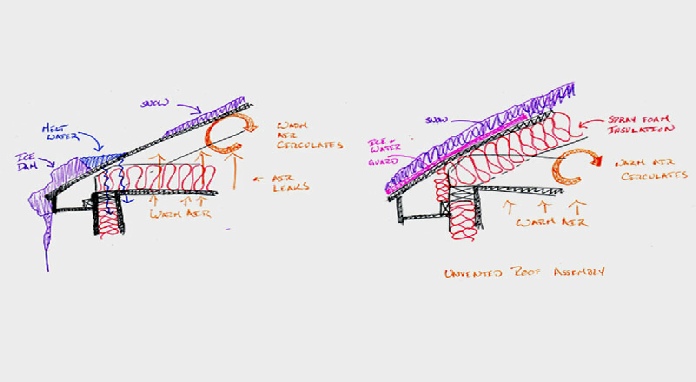






Winter has finally decided to arrive in Iowa. The trees glisten with ice, snow blankets the corn fields, and cars go careening down the highways. Unfortunately, the cold can be as hard on our houses as it is on our lifestyles. Have you ever driven through town and noticed large chunks of ice and snow mounded up over the gutters of the homes? Sometimes they drip long icicles down the siding. As lovely as they are, these "ice dams" pose a significant problem for our houses.
Under-
Ice dams are prevented by keeping the roof surface cold enough to eliminated melting. There are several ways to accomplish this. Ventilated roofs continually pass outside air under the roof sheathing through vents at the roof's eaves and ridge. If your home has an attic, the attic itself is ventilated and kept at exterior temperatures. Sufficient insulation must be installed at the attic floor, and the ceiling below must be sealed with caulk to prevent warm air from leaking in. Cathedral ceilings require the maintenance of a 1" to 2" space between the insulation and the roof sheathing to allow air to flow uninterrupted through the rafter cavity.
I prefer to use unvented roofs in my home designs. Unvented roof surfaces are kept cold by placing rigid foam insulation panels over the roof sheathing or by applying spray foam insulation directly to the underside of the sheathing, covering the roof rafters. The insulation levels must be sufficient to prevent the warm air from reaching the roof surface, and they must be completely air sealed. Spray foam is ideal for this application because it automatically air seals your framing. Unvented roofs provide the bonus of a conditioned space to run your HVAC ducts.
Regardless of whether you use a vented or unvented roof, you must apply an ice barrier to your eaves. Commonly sold as "ice and snow guard," this product is a self-
Ice dams are bad news, and they are very common in old houses throughout Iowa. Fortunately, they are pretty easy to remedy, and the added insulation and sealant will help with your heating and cooling bills as well. So next time you pull into your driveway take a close look at your gutter, and have a happy, warmer new year!


